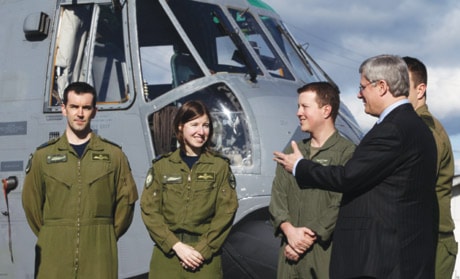OTTAWA — A Defence Department study says it’s risky for the air force to continue using Griffon helicopters for search and rescue in Central Canada.
The review by the chief of air force development cites limitations of the CH-146, pressed into service in 2005 at Canadian Forces Base Trenton, Ont., because the military’s principal search helicopter is often not available.
The air force intends to keep using the Griffon at the base until at least 2014, say briefing notes for Defence Minister Peter MacKay.
But the 2009 air force study, obtained under the Access to Information Act, said the helicopter’s “capabilities are challenged” when employed as a front-line rescue aircraft and its use constitutes a “risk.”
The CH-146, a military version of the Bell 412 civilian chopper, is too small and lacks the range to reach wilderness sites in Northern Ontario and Quebec without refuelling.
Having to stop for gas “increases the response time to an incident site, and the amount of time the helicopter can remain on the scene to perform rescue tasks,” said the 20-page censored report.
It noted one incident where search-and-rescue technicians were lowered to a crash site “and the helicopter departed the scene to refuel before extracting the casualties.”
The chopper has no GPS, no all-weather radar, limited communications, no flotation equipment and no de-icing system, which is imperative in winter rescues. The small size of the Griffon cabin means there’s room for a maximum of two stretchers.
“But patient care is nearly impossible in those circumstances,” said the study. “Up to four seated evacuees could be transported, but this assumes no SAR techs (search-and-rescue technicians) would accompany them.”
Air force planners are particularly nervous about using Griffons over the Great Lakes because it has no emergency flotation devices.
“In a ditching scenario, the aircraft would sink quickly and most likely roll over in the process leaving very little time for the crew to safely egress.”
SAR techs are supposed to don immersion suits when conducting a water rescue, but the outfits are not designed for continuous wear —and the report noted there’s little room in the cabin for the two highly trained members to change. The chopper would have to land prior to heading out over the water to give them time to change.
The Defence Department was told to consider modifications to the Griffon.
Jack Harris, the NDP’s defence critic, said search-and-rescue is part of the function of government.
“The Canadian people deserve a first-rate, world-class search-and-rescue service,” he said. “The government should find the resources to do it. Canada lags behind the rest of the world.”
Bloc Quebecois defence critic Claude Bachand said it’s been clear for a long time the CH-146 wasn’t suitable for the role in Trenton, but the findings of the study are “very alarming” and the Conservative should recognize that SAR is an essential service.
“If there are search and rescue missions going today with the Griffon, I don’t think that’s the proper helicopter to do that,” he said. “It’s a temporary solution and we definitely need to see another way of rescuing people.”
The House of Commons defence committee has been studying the long delays associated with buying a fixed-wing search plane, which was first promised in the 2004. Bachand said MPs have found gaping holes in the system, most notably with response times.
He said the limitations of the Griffon only make it worse.
At the centre of the problem is the lack of availability of the Cormorants, which began service almost a decade ago with much fanfare.
The study questioned whether Ottawa should have bought more than 15 of the helicopters, which have been hobbled by a lack of spare parts. It noted the high cost of buying either new — or used — Cormorants to buttress the existing fleet, which is restricted to operations on the East and West Coasts.
Harris said the Harper government should buy more Cormorants to cover the gap.
